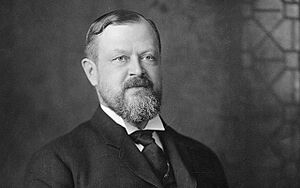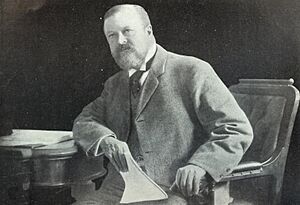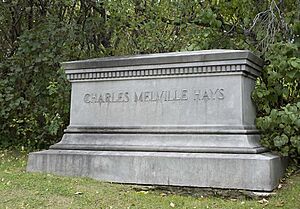Charles Melville Hays facts for kids
Quick facts for kids
Charles Melville Hays
|
|
|---|---|

Charles Melville Hays
|
|
| Born | May 16, 1856 Rock Island, Illinois, United States
|
| Died | April 15, 1912 (aged 55) |
Charles Melville Hays (born May 16, 1856 – died April 15, 1912) was an important leader in the railroad world. He became the president of the Grand Trunk Railway in Canada. Charles started working for railroads when he was just 17 years old. He quickly moved up to become a top manager.
He helped save the Grand Trunk Railway from financial trouble. He also had a big dream: to build a second major railway across Canada. This new railway was called the Grand Trunk Pacific Railway (GTP). Sadly, Charles Hays died when the RMS Titanic sank. This happened before his big railway project was finished.
Contents
Early Life and First Jobs
Charles Melville Hays was born in Rock Island, Illinois, on May 16, 1856. When he was a child, his family moved to St. Louis, Missouri.
In 1873, at age 17, Charles began his career. He worked for the Atlantic and Pacific Railroad in St. Louis. He learned a lot about how railroads worked. From 1877 to 1884, he was a special assistant to the General Manager of the Missouri Pacific Railroad.
Rising in the Railroad World
Charles Hays continued to gain experience. He became the General Manager of the Wabash, St. Louis and Pacific Railway in 1886. By 1889, he was the Vice-President of the Wabash Railroad.
In 1896, Charles became the General Manager of the Grand Trunk Railway (GTR) in Canada. The GTR was struggling at this time. Charles helped to make the company much stronger. He improved how the company was run and made it more efficient. He also built new tracks and ordered better trains. These changes made the GTR very successful.
In 1901, Charles briefly left the GTR. He became the President of the Southern Pacific Railway Company. But he returned to the GTR in 1902. By October 1909, he was made the president of the GTR. This meant he was in charge of many other smaller railway and steamship companies connected to the GTR.
Charles was also known for his kindness. He helped manage several charities and hospitals. In 1907, the Emperor of Japan gave him a special award. It was called the Order of the Rising Sun. He received it for helping Japan's Imperial Government Railways.
Building a Transcontinental Railway
Charles Hays had a huge dream. He wanted to build a new railway that would cross all of Canada. This railway would stretch 3,600 miles. It would go from Moncton, New Brunswick, all the way to Prince Rupert, British Columbia.
In 1900, he suggested extending the GTR's lines. But the company's leaders in London said no. Later, the Canadian government, led by Prime Minister Sir Wilfrid Laurier, also decided to support the project. Plans for this new railway were announced in November 1902.
Charles's plan involved creating a new company. It was called the Grand Trunk Pacific Railway (GTP). The government would build part of the line. The GTP would build the rest.
There were some challenges with Charles's plan:
- He wanted to buy out another railway company, the Canadian Northern Railway. But they refused and became a competitor.
- He chose Prince Rupert, British Columbia, as the western end of the railway. Some people thought this was a bad choice. They felt there wasn't enough business there. But Charles believed it would be a shorter route for shipping goods to Asia.
Charles focused on building the main railway line. He didn't build enough smaller lines to connect to it. This meant the GTP didn't get enough traffic. Even though it was a great railway, it struggled to make money.
After construction began in 1905, Charles started another company. This company bought land along the railway route. He created new towns, like Melville, Saskatchewan, which was named after him. Charles also dreamed of having a fleet of ocean liners. He also wanted to build fancy hotels across the Rocky Mountains. He even hired a famous architect to design a grand hotel in Prince Rupert.
In 1909, Charles became the president of the GTR. By 1910, workers were demanding higher wages. A strike stopped construction. Charles eventually agreed to their demands. However, he didn't re-hire all the workers he had promised.
By 1912, the cost of building the railway was growing. Wages and material prices were rising. The government wouldn't let the railway charge more for shipping. Charles began to worry that the company would run out of money.
Aboard the RMS Titanic
In April 1912, Charles Hays was in London. He was trying to get more money for the GTP railway. He was eager to return to Canada. He wanted to be there for the opening of the Château Laurier hotel in Ottawa, Ontario. This big event was planned for April 25, 1912. He also heard that his daughter Louise was having a difficult pregnancy.
Charles Hays and his family boarded the new ship, the RMS Titanic. He was traveling with his wife, Clara, his daughter Orian, his son-in-law Thornton Davidson, his secretary Mr. Vivian Payne, and a maid, Miss Mary Anne Perreault. They had a fancy suite of rooms on B Deck.
At 11:40 pm on April 14, 1912, the Titanic hit an iceberg. Charles helped the women in his group get into one of the ship's lifeboats. But he, his son-in-law, and his secretary stayed behind. They died when the ship sank. Nearly 1,500 other people also died that night.
It is said that Charles Hays made a remark before the disaster. He was worried about how fast steamship companies were building ships. He supposedly said, "The time will come soon when this trend will be checked by some appalling disaster."
Death and Burial
Charles Hays was a victim of the Titanic sinking. His body was found in the North Atlantic Ocean by a ship called the Minia. He was buried at Mount Royal Cemetery in Montreal, Canada. Two funeral services were held for him on May 8, 1912.
Charles Hays' Legacy
Charles Hays died before his dream of the GTP railway was finished. People remembered him as one of Canada's greatest railway leaders. On April 25, 1912, work on the GTR stopped for five minutes to honor him. The time when Charles led the GTR was its most successful period.
However, some of his decisions led to the GTP's collapse in 1919. The government took over the company. Some people later said that Charles had made promises to the Canadian government that the GTR's leaders in London didn't agree with. This was blamed for the company's downfall.
The special railway car that carried his body back to Montreal is now kept at the Canadian Railway Museum. This museum is near Delson, Quebec. There is a statue of Charles Hays in Prince Rupert. The city of Melville, Saskatchewan, is named after him. So is the village of Haysport, British Columbia. Even Mount Hays, a mountain south of Prince Rupert, is named for him. Charles Hays Secondary School in Prince Rupert also carries his name.
Personal Life
Charles Hays married Clara Jennings Gregg on October 13, 1881, in St. Louis, Missouri. They had four daughters: Orian, Clara, Marjorie, and Louise.



